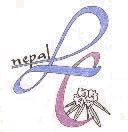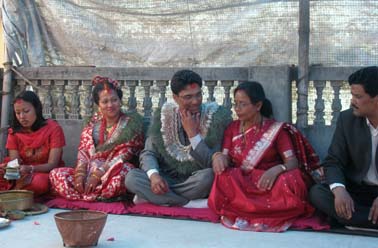 ラリグランス通信 31号
ラリグランス通信 31号 ラリグランス通信 31号
ラリグランス通信 31号[Laligurans Note No.31]
2007.5.12.発行
バンディプールにて Photo by SONOKO
ゴールデンウイークも終わり新緑の季節を迎えました。
ネパールでは総選挙の見通しもつかないまま
モンスーン期に入り連日暑い日が続いているそうです。
☆ ☆ ☆ ☆ ☆ ☆ ☆ ☆ ☆
<<< 31号 目次 >>>
| 31号 目次 | No.31 Index | |
| 1 | ネパールでの活動報告 * 識字教室 * 奨学児童の今 * バザー用ネパール商品 |
Activities in Nepal * Woman Education Program * Scholarship Children * Knitting goods & Pouch |
| 2 | 日本での活動報告 * ネパールグッズの販売 * 寄付金 |
Activities in Japan * Sale Nepalise Good * Donation |
| 3 | スマナさんの結婚 | Sumana’s Wedding |
| 4 | モティさんの小論文 「カーストとダリット(不可触民)」 |
small article [the castes and dalit] by Moti Ghimire |
| 5 | あ と が き | Rostscript |
☆ ☆ ☆ ☆ ☆ ☆ ☆ ☆ ☆
![]()
[ Activities in Nepal ]
* WEP(識字クラス)
識字クラスに3名の新しい生徒が加わりました。
生徒のディリさんが胆嚢炎で具合が悪く4mmの胆石があることが分かりました。医者の診察を受けさせ経過をみています。
* スカラシップの子供達
子供達は全員好成績で進学出来ました。
・シリスティ・・・・・成績60.45% 2年生に進級
・ビシャル・・・・・・成績93%(学年4番) 1年生に進級
・アヌパ・・・・・・・・成績91.01%(学年6番) 1年生に進級
・アシャ・・・・・・・・成績77.5%(学年5番) 4年生に進級
・クリシュナ・・・・・成績結果は未だ
・マドゥウ…・・・成績54% 6年生に進級
![]()
![]()
[ Activities in Japan ]
* バザーのための商品準備
☆ 編み物製品やカモシカ皮ポーチなどをネパールを訪問された方たちが少しずつ持ち帰って下さっています。
毛糸の製品は引き出しに保管中ですが、カモシカ皮手刺繍ポーチとバッグは現在もよく売れています。
* 運営資金のために
☆ 本年度も昨年に引き続き、神戸のコープともしびボランティア振興財団に助成金を申請しました。
申請が認められ、5月9日、63000円の助成金を受け取りました。
☆ 本年度も京都ノートルダム女子大学同窓会より50000円の寄付金を頂きました。
☆ 30号以降の資金提供者
吉野和子様 匿名希望者様:3名
☆ ネパールグッズ販売協力
石原圭子様 稲富千佳子様 本田ゆう子様
![]()
![]()
(最後に翻訳文も合わせて載せています。)
|
about the castes and dalit Moti Ghimire Katmandu, Nepal Caste is social
divisions which are ranked in consideration of marriage and occupation. People
of similar castes share similar thoughts and morality. The general
characteristics of caste system can be compared with other system of division
such as those based on class or race. Undeveloped forms of caste exist in many
parts of the world but caste organization and ideas are compared to such extent
in Hindu societies that some scholars have considered caste a unique Hindu
phenomenon. In Hindu society caste is merited and also linked to occupational
struggle. The occupation was appointed to them according to their varnas (colors). The moral order of Vedic society was upheld through
sacrifice, from which all varnas were
benefited and to which they all contributed in different ways. The sudras offered his labor and services. The
vaisyas were the farmers and looked
after the cattle and provided the wealth earned in sacrifice to gods. The chettriyas had royal power, superior
wealth and could also command and protect the vaishyas. The Brahmans possessed godly power and were
the only ones who could perform sacrifices for the chettriyas and vaisyas, for
which they received gift from them. in this way, among Brahmans, chettriyas, vaisya and sudras, workers of sudras fell in the world of slavery(どれい). They performed the works dealt with
iron, skin, cleaning the roads, cutting and selling of meat which were dishonored
in the society. They were tortured and hated. So they wanted to get rid of
their works and tried to do other things. But the rules were made against them
and whoever tried to break the rules, were badly punished and sometimes even
hanged to death. In this way, the division of castes which was derived from
the division of occupation took a place of touchable
and untouchable in the society. Because of this, in ancient times, the
people of higher caste used to look down upon the people of lower caste. The
caste division was not a scientific fact but just a religion belief. If the people
touch the water, and that is accepted by the others, they are called water
acceptable caste(higher caste). for eg. brahmans, chettri, newar, etc. The works the lower caste were engaged in Later on these lower caste people were given the title 'dalit The sufferings the lower caste people bore:
One of the teachers
said that “being a student, they were not supposed to go to claim for human
rights nor inform the reporters; rather they were supposed to inform the school
authority." ・・・・・・・・・・・・・・・・・・・・・・・・・・・・・・・・・・・・・・・・・・・・・・・・・・・・・・・・・・・・ Madhu Biswakarma, one of the dalit who was helped for her
studies by laligurans club has her own story. |
|---|
[ カースト と ダリット について ] モティ・ギミレ記(日本語翻訳)
この世の中には、ヒンドゥ社会に住むダリット(不可触民)という人たちの存在を知らない人が沢山います。カースト制度、そしてダリットという人たちについて知ってもらうために、この記事を用意しました。
カーストは、結婚や職業を考える上で、階級付けされている社会的区分です。考え方や道徳観も、それぞれのカースト階級によって異なっています。カースト制度の一般的な特徴や性格を、社会階級的な区分や民族や人種といった区分制度とよく似たものであると言われることがあります。
カースト制度の未発達のようなものが世界中のあちこちで存在していますが、ヒンドゥ社会でのカーストの組織や考え方はそのような広がりと比べて、ヒンドゥ独特の事象であるという学者たちも中にはいます。
ヒンドゥー社会ではカーストはあって当たり前と考えられていますが、職業的な葛藤とも結びついているのです。
ネパールでは、カーストの区分けは、数千年も前から始まり、そして今現在に至っています。古代、ヴェータ社会とよばれる時代に、カーストは人々が営んでいた職業によって分けられただけではなく皮膚の色で分けられました。古代のヴェルナ(色)によるカースト区分は次のとおりです。
バラモン・・・・・ 白ヴェルナ(ホワイトカラー)
クシャトリヤ・・・赤ヴェルナ(レッドカラー)
ヴァィシャ・・・・・黄ヴェルナ(イエローカラー)
シュードラ・・・・・黒ヴェルナ (ブラックカラー)
ベェルナ(色)階級では人々の職業は決められています。ヴェータ社会ではそれらに身をゆだねることが美徳とされていました。つまり、そうすることで、全てのヴェルナ階級が利益を得て、そして全ての人たちがいろいろな違った形で貢献しているのでした。シュードラは労働やサービスを提供する。ヴァィシャは農業に従事したり、牛の世話をすることで、神にお供えするものを作っている。クシャトリヤは、王者の権限や富を持ち、またヴァィシャの人々を指揮、保護することも役目である。バラモンは聖なる力を保持し、クシャトリヤやヴァィシャの人々のために、彼らから贈り物を頂き、神聖行事を執り行うことができる階級でした。
このような、バラモン、クシャトリヤ、ヴァイシャ、シュードラの歴史の中から、シュードラの労働者たちが、いわゆる奴隷世界に振り落とされていったのです。彼らは、製鉄、皮革、道路掃除、屠殺、精肉といった仕事に従事していたので、そのことが社会から軽蔑視されることにつながりました。彼らは、差別され、ひどい苦痛に耐えなければなりませんでした。仕事をやめ、他に何か違うことをしようとする人もいましたが、しかし、それらの行為を禁ずる規定が作られ、その規定に反する人は誰であっても、重く罰せられ、時には死刑になることさえありました。
過去の860年間のヴェーダ社会や宗教哲学社会がきっかけとなり、ベェルナ階級に違ったカーストが導入されました。1606年〜1636年、ネパールを支配した王は、「4色(ベェルナ)の階級に36カースト制度」を導入し、これらはさらに細分されました。
区分は次のとおりです。
バラモン― このカーストの中もさらに細分化されている。例えば、アプジャヤバラモン、ジャイシバラモン、クマイバラモンなど。
クシャトリ― サクリ、カトリ、クシャトリなど
ヴァィシャ― 高位ネワーリ、シュレスタ、ジャシ、バジャラシャヤ、アダス など
シュードラ― サンワー、低位ネワーリ、サラ など
不潔不可触民 ヴィシュワーカルマ、ミジャ、パリヤなど
このように仕事の区別から始まったカースト制度は、のちの社会に“可触民”と“不可触民”を生み出したのだった。これがきっかけとなり、昔の人々は、高いカーストの人々は、低い身分の人々を軽蔑するようになった。カースト制は、科学的事実によるのではなく、ただ宗教的な信念からであった。
身分の低いカーストの人たちは、畜生と同じような人生を生きなければならなかった。身分の高いカーストの人々が、低位カーストのものを支配し、また様々な規則がきめられた。例えば低位カーストの人はよい服を着てはいけない、レンガ作りの家を建ててはいけない、街から離れた川沿いの未開発地域に住まなければならないなどというように。
1853年のネパール法典では、社会は、法律上、二つの階級に分けられた。“水を享受出来るカースト”と“水に触ることのできないカースト”である。
もし人が水に触ってその水が他の人たちに受け入れられたら、彼らは“水にさわることのできるカースト”つまり高位カーストである。例えば、バラモン、クシャトリ、ネワールなど。
そして、逆に水が他の人たちに受け入れてもらえなかったら、彼らは“水に触ることのできないカースト”低位カーストになる。ミジャール、ヴィシュワカルマ、ダマイなでどである。
低位カーストの人たちが従事している仕事には、次のようなものがある。
A 武器などを製造している人々は、ビスワカルマ、ソナー、カミなどと呼ばれている。
B 装飾関連、また楽器製造者は、スチカ、ドメイン
C 皮革や製靴に従事する人は、サリキ、ミジャ
D 歌うことを職業としていた人は、ゲイン
このように、沢山の区分けがあるのです。
そして、その後、このような低位カーストの人たちに、ダリットという名称が与えられるようになったのです。そして、そのダリットたちが受けた仕打ちとは、
A 高位カーストのものは、ダリット民を、好きなように扱ってよい。
B ダリット民はあまりにも地位が低すぎて、ヒンドゥ教徒とは認められないで、お寺に出入りしてはいけない。
C お祭りに参加することは禁じられ、そして、集会に参加することもいけない。
D 供水場に近寄ってはいけない。
このようなダリットへの制約のために、この人たちの人生はさらに悲惨になり困難なものになった。そして今日ですら、このような慣習は暗黙の了解となっている。
ダリットの人々は、高位カーストの人々と一緒に食事をしてはならない。同階級の結婚しか認められていない。高位カーストの人々の家に入ることも禁じられているし、ほとんどのお寺や火葬場、給水設備、ホテル、商店などといった公共の場にすら、入ることは禁じられている。
カトマンズといった都市であっても、ダリットの人たちが一生涯与えられたカースト階級だからと言ういわれのない差別から、ダリットへ対する卑劣な考え方はいまだに改善されていない。
このように、ダリットの人たちは、経済的にも、政治的にも、社会的にも、人間の当たり前の権利から取り残されている。教育を受けることも難しく、またそのことによって、彼らの生活水準がより低いものとなっているのだ。
このような差別の実例を、例えばパルバト地方の学校ではっきり見受けることが出来る。
(これは、カンティプールという有名な日刊新聞(2007年4月)からの記事です。)
数名の生徒たちは調理の時間に、ダリットのため、テストを受けることができなかった。
教師は、バルバトにあるマジャファト村の6、7年生の生徒たちに、職業訓練としての調理のテストに出席させなかった。
ダリットの生徒たちの話によると、 [先生は私たちに「他の生徒がここで料理をしているのだから太鼓でも叩いていなさい」と言って、さらに「ダリットの人間が料理した食事を食べる他の生徒の気持ちを考えたことがあるのか」とまで付け加えた。]と言う事です。
テストは11時ちょうどから始まるはずだったが、教師はダリットの生徒が食べ物に触ることを嫌い、ダリット以外の生徒たちを早い時間に来させた。ダリットの生徒が到着する前には、すでに調理のテストを終わらせていたのだった。
教師はさらに「あなたたちはここの生徒なのですよ。人間の権利を求めたり、訴えたりすべきではありません。学校の規則に従わねばなりません。」と言いました。
ダリットの生徒たちは、郡政府に自分たちの人権を求めに行った。そして、もし何の手立てもとってもらえないのなら、ストライキを起こすと強く主張した。

(調理の試験を受ける権利を得たダリットの生徒達 )
・・・・・・・・・・・・・・・・・・・・・・・・・・・・・・・・・・・・・・・・・・・・・・・・・・・・・・・・・
ラリグランスクラブの支援によって勉強を続けているマドウ・ビスワカルマさんも、ダリットの生徒の一人です。(註:通信30号参照)彼女にはこんな話がある。
マドゥ・ビスワカルマさんは、家族と一緒に故郷からカトマンズに移り住んだ。マドゥさんは生まれたときから目が見えません。
私は、彼女のことをよく知りたいと思い家を訪ね名前と姓を尋ねた。彼女の母親は自分たちたちよりもいくらか高いカーストの名前を告げたが、色々話をしているうちに彼女は真実を明らかにしダリットであることを打ち明けた。
彼女は小さなお店をやっている。もし彼女がダリットだと分かれば、だれもこのお店には入ってこないし買ってもくれないと言う。近所の人は、私たちの本当のカーストを知りません。私たちは、みんなにダリットである事を隠し違うカーストであるといい続けています。
私は彼女のこの話を聞いて大変衝撃を受けました。
彼女の家族は、ダリットで貧しく、そのうえ娘のマドゥは目が見えません。
私たちラリグランスクラブでは彼女のために学業と音楽を学ぶための支援をすることを決めたのでした。
![]()
![]()
1 2
2 

ラリグランスクラブを立ち上げる時からお世話になっている元留学生スマナ・シュレスタさんが4月20日にネパールで結婚されました。
式はネワールの古式にのっとって行われたということです。
お相手は山梨大学博士課程修了のあと研究職員として勉強中のネパール人のサンガムさんです。
工学部で水質について研究されています。彼の研究生活はあと1年残っています。
式を終えてから日本に来られましたが家族ビザが間に合わずスマナさんはネパールに戻られました。
カトマンズで家族ビザを取ってからまた日本に来られます。
これからも、ご夫妻に何かとご協力願うこともあるでしょう。
サンガムさんご夫妻のご結婚を祝しこれからの人生が幸多かれと心からお祈りいたします。
(写真1.サンガムさん&スマナさん 写真2.スマナさんの両親と友人 写真下段.サンガムさんの家族と花嫁)
![]()
![]()
[ Postscript ]
31号はスマナさん結婚というおめでたいニュースを載せることが出来ました。
モティさんからの小論文「カーストとダリット」は複雑なカーストの問題を分かりやすく教えてくれました。
低いカーストに生まれてしまったために過酷な人生を強制されてしまう人々を少しでも救うためには
多くの人々からの善意と理解と行動力が必要とされます。
ラリグランスクラブからスカラシップを受けている子供達は全てダリットです。
楽器を寄贈したマドゥさんの学校長から受領書と丁寧な礼状が届きました。

追記:(掲示板に書きましたが、、)
トップページでは英語説明文を書き加えたり、モティさんの英語の原文をのせたりして、「何故英文を?」と不思議に思われた方がいます。
英文を載せた理由は、パソコンに日本語ソフトを入力していない友人のためです。モティさんやスマナさんがネパールの友人にラリグランスクラブを紹介する時にも、今までは写真だけ見てもらってましたが、英語文もあればもっと親切かと思いました。スカラシップを受けている生徒の学校の校長先生たちにも見ていただけます。
英語バージョンを作るのは今の私にはシンドクて出来ません。
他にも意見や提案があればどんどん言っていただくと嬉しいです。
| ホームページ作成 | 五十嵐園子 |
|---|---|
| ホームページアドレス | http://laligurans.com/ |
| 郵便振込口座 名義:ラリグランスクラブ |
00960-7-244821 |
| 翻訳協力 | 谷澤史子 久堀洋子 |